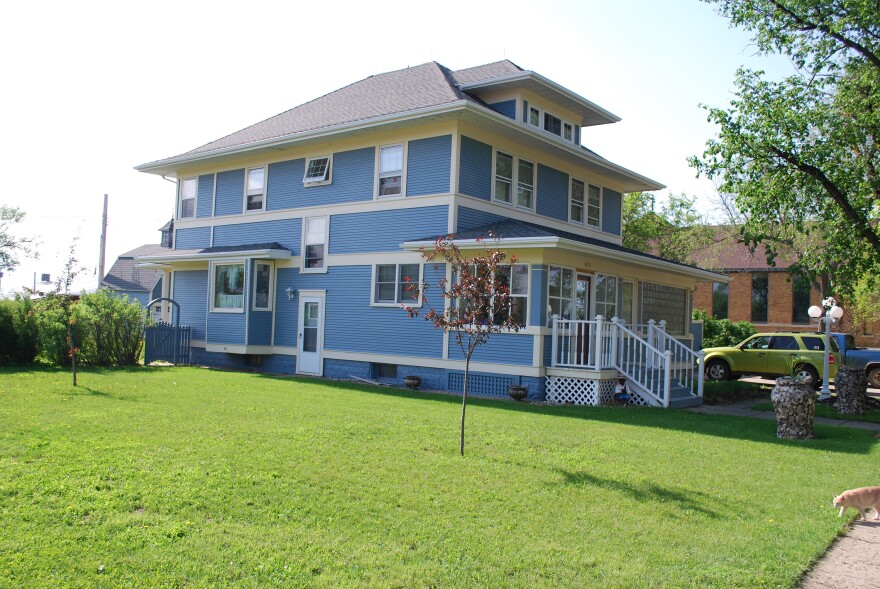The South Dakota State Historical Society has announced the addition of seven properties to the National Register of Historic Places.
The National Register is the official federal list of properties identified as important in American history, architecture, archaeology, engineering and culture. The recently listed properties are:

Murdo State Bank
Murdo
The Murdo State Bank is located on Main Street in Murdo. It is listed on the National Register for its commercial style architecture with Classical embellishments. It is also significant for the role it played in commerce. The bank was organized in 1906, which preceded the founding of Murdo by two months. The original location of the bank is one block north of the current bank, which was constructed in 1920.

Kudrna Homestead and Ranch
Scenic vicinity
The Joseph and Marie Kudrna Homestead and Ranch was claimed in 1910. Located in the Scenic vicinity of eastern Pennington County, it is listed on the National Register for its homesteading and agricultural significance. It is also listed for its vernacular architecture found in the collection of structures on the ranch. Joseph and Marie engaged in diverse and small-scale cultivation in the early years and continued to prove up on the land. The farm continued to expand and switched over to livestock production in the 1930s. The ranch continued to grow over the years as neighbors moved away and more land was acquired.

Anderson-Ridley Ranch
St. Onge vicinity
The Rasmus and Elemine Anderson Homestead and Ranch has been listed on the National Register for its homesteading significance and the agricultural contribution it made to the region. Homesteaded in 1883, it is also significant under architecture for the variety of buildings constructed on the ranch over the years. It is located in the St. Onge vicinity of Lawrence County.

Concrete Interstate Tipis
Along I-29 and I-90
Between 1968 and 1979, nine concrete tipis, designed by Watertown native Ward Whitwam, were constructed at rest areas in South Dakota. Seven were constructed on Interstate 90 and two on Interstate 29. The tipis are listed on the National Register as works of art. They are also significant under transportation for the contributions they made to the Interstate Highway System and under tourism for honoring South Dakota’s American Indian heritage.

Drake Claim House
Colman vicinity
The Frank and Sarah Drake Claim House is a small frame house built around 1880 on the Drake’s homestead claim in the Colman vicinity of Moody County. Their son moved the house to his property just south of his parents’ claim in about 1907. While many claim houses in South Dakota were demolished, reused as agricultural outbuildings, or expanded into larger residences, the Drake Claim House is listed on the National Register for its ability to tell the story of homesteading in Moody County.

Norbeck-Nicholson Carriage House
Redfield
The Norbeck-Nicholson Carriage House was built around1907 for neighbors Peter Norbeck and Charles Nicholson, partners in an enormously successful artesian well business based in Redfield. It has been listed on the National Register for its significant association with early local trends in vehicular transportation and for its architectural significance as a rare intact local example of a masonry carriage house.

Quamman House
Lemmon
The Quamman House in Lemmon was built in 1910 and is listed on the National Register under architecture as an example of the Prairie Style. This style of architecture was popular from 1900 to 1920 in the United States. The acknowledged founder of the style was architect Frank Lloyd Wright. It was used on a variety of buildings such as schools, businesses, public buildings, institutions and residences. The Prairie style eventually filtered down into vernacular interpretations like the Quamman House.
The State Historic Preservation Office of the State Historical Society at the Cultural Heritage Center in Pierre works in conjunction with the National Park Service, which oversees the National Register program, to list properties.
"South Dakota's history is rich in American Indian culture, pioneer life and change," said Jay D. Vogt, state historic preservation officer and director of the State Historical Society. "Properties listed on the National Register are important for their role in South Dakota's culture and heritage. And when properties get listed, it shows that their owners take pride in their role in preserving that history."
Buildings, sites, structures and objects at least 50 years old possessing historical significance may qualify for the National Register, according to Vogt. Properties must also maintain their historic location, design, materials and association. Listing on the National Register does not place any limitations on private property owners by the federal government.
For more information on the National Register or other historic preservation programs, contact the State Historic Preservation Office at the Cultural Heritage Center, 900 Governors Drive, Pierre, SD 57501-2217; telephone (605) 773-3458 or website history.sd.gov/Preservation and click on “National Register of Historic Places” in the right column.
Related

